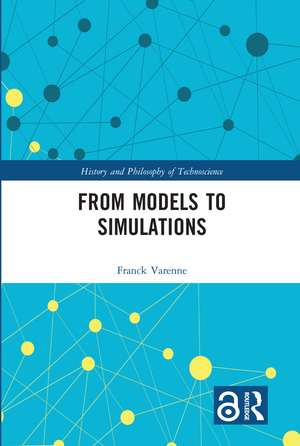From Models to Simulations: History and Philosophy of Technoscience
Autor Franck Varenneen Limba Engleză Paperback – 30 iun 2020
Using historical, comparative and interpretative case studies from a range of disciplines, with a particular emphasis on the case of plant studies, the author shows how and why computers, data treatment devices and programming languages have occasioned a gradual but irresistible and massive shift from mathematical models to computer simulations.
| Toate formatele și edițiile | Preț | Express |
|---|---|---|
| Paperback (1) | 257.68 lei 6-8 săpt. | |
| Taylor & Francis – 30 iun 2020 | 257.68 lei 6-8 săpt. | |
| Hardback (1) | 1001.39 lei 6-8 săpt. | |
| Taylor & Francis – 6 sep 2018 | 1001.39 lei 6-8 săpt. |
Din seria History and Philosophy of Technoscience
-
 Preț: 310.65 lei
Preț: 310.65 lei -
 Preț: 311.18 lei
Preț: 311.18 lei -
 Preț: 386.18 lei
Preț: 386.18 lei -
 Preț: 469.34 lei
Preț: 469.34 lei -
 Preț: 486.38 lei
Preț: 486.38 lei -
 Preț: 469.34 lei
Preț: 469.34 lei - 17%
 Preț: 259.98 lei
Preț: 259.98 lei -
 Preț: 467.44 lei
Preț: 467.44 lei -
 Preț: 468.97 lei
Preț: 468.97 lei -
 Preț: 381.00 lei
Preț: 381.00 lei - 30%
 Preț: 821.53 lei
Preț: 821.53 lei - 31%
 Preț: 792.03 lei
Preț: 792.03 lei -
 Preț: 449.41 lei
Preț: 449.41 lei -
 Preț: 492.96 lei
Preț: 492.96 lei -
 Preț: 382.75 lei
Preț: 382.75 lei -
 Preț: 383.71 lei
Preț: 383.71 lei - 22%
 Preț: 259.98 lei
Preț: 259.98 lei -
 Preț: 389.38 lei
Preț: 389.38 lei -
 Preț: 386.99 lei
Preț: 386.99 lei -
 Preț: 391.65 lei
Preț: 391.65 lei -
 Preț: 311.47 lei
Preț: 311.47 lei -
 Preț: 389.66 lei
Preț: 389.66 lei - 18%
 Preț: 1001.90 lei
Preț: 1001.90 lei - 18%
 Preț: 1057.09 lei
Preț: 1057.09 lei
Preț: 257.68 lei
Preț vechi: 332.84 lei
-23% Nou
Puncte Express: 387
Preț estimativ în valută:
49.32€ • 53.59$ • 41.46£
49.32€ • 53.59$ • 41.46£
Carte tipărită la comandă
Livrare economică 21 aprilie-05 mai
Preluare comenzi: 021 569.72.76
Specificații
ISBN-13: 9780367586621
ISBN-10: 0367586622
Pagini: 236
Dimensiuni: 156 x 234 mm
Greutate: 0.34 kg
Ediția:1
Editura: Taylor & Francis
Colecția Routledge
Seria History and Philosophy of Technoscience
Locul publicării:Oxford, United Kingdom
ISBN-10: 0367586622
Pagini: 236
Dimensiuni: 156 x 234 mm
Greutate: 0.34 kg
Ediția:1
Editura: Taylor & Francis
Colecția Routledge
Seria History and Philosophy of Technoscience
Locul publicării:Oxford, United Kingdom
Public țintă
PostgraduateNotă biografică
Franck Varenne is Associate Professor of philosophy of science at the University of Rouen (Normandy – France) and associate researcher at IHPST (CNRS – Paris). His research focuses on the history and epistemology of formal models and computer simulations in contemporary science, especially in biology and geography. He has published around fifty-five articles and chapters. He has also published eight books and co-edited three collective books.
Cuprins
Contents ; List of figures;Acknowledgments ;List of French abbreviations ; Introduction ; Chapter 1 – Geometric and botanic simulation ; 1 The probabilistic simulation of branching biological shapes: Cohen (1966) ;2 The epistemic functions of modular programming, simulation and visualization;3 The first geometric and realistic simulation of trees (Honda-Fisher, 1971-1977) ;4 The limitations of morphometry and of thermodynamics of trees ;5 The first geometric simulation of an actual tree: Terminalia ;6 A recap of geometric simulation ; Chapter 2: The logical model and algorithmic simulation of algae ; 1 A botanist won over by logical positivism: the theory of lifecycles by A. Lindenmayer (1963-1965) ;2 Unusable set of axioms and used set of axioms ;3 From logical theory to automata theory (1966-1967) ;4 The developmental model and the rules of rewriting (1968) ;5 The dispute with Brian Carey Goodwin regarding natural formalisms ;6 Recap: the computer as automata model and deductive machine; Chapter 3: The limitations of biometric models and the transition to simulation in agronomy; 1 The institutional and technical context of the IFCC (1966-1971);2 Transferring a little bit of econometrics to biometrics: a problem of optimization (1974);3 The first application of plant simulation in agronomics (1974-1975) ;4 Fragmented modelling and geometric simulation: de Reffye (1975-1981);5 Simulation, imitation and the sub-symbolic use of formalisms; Chapter 4: A random and universal architectural simulation ; 1 Making headway in botany: the notion of architectural model (1966-1978) ;2 The search for botanical realism (1978-1979) ;3 Criticisms of theoretical models ;4 Criticisms of biometric models ;5 A mixed reception (1979-1981); Chapter 5: Convergence between integrative simulation and computer graphics ; 1 The relaunch of research into architectural simulation (1985-1991) ;2 Jaeger’s thesis: the prefixed model and synthesis of botanical images (1987) ;3 Blaise’s thesis: the simulation of buds parallelism (1991) ;4 How can an integrative simulation be validated?; Chapter 6: Convergence between universal simulation and forestry (1990-1998) ; 1 An epistemological dispute between modellers: INRA and CIRAD ;2 Conceptual and institutional convergence: the CIRAD/INRA partner laboratory (1995);3 The empirical value of simulation ;4 Supra-simulations ; Chapter 7: The remathematization of simulations (from 1998 onwards) ; 1 The first mixed structure-function model: water efficiency (1997-1999) ;2 The parallel evolution of algorithmic simulation: 1984-1994 ;3 Simulating the individual plant in order to observe crop functioning (1997-2000) ;4 The association between AMAP and INRIA: sub-structures and factorization (1998-2006);5 Recap: pluriformalized simulation and convergence between disciplines; Chapter 8: Twenty-one functions of models and three types of simulations – Classifications and applications ; 1 General function, main functions and specific functions of models ;2 General characterization and classification of computer simulations ;3 System simulation, model simulation, system-simulation model and model-simulation model ;4 Applications to different plant models and plant simulations; Conclusion ; Glossary ;Selected Bibliography ;Index of names ;Index of subjects
Descriere
This book analyses the impact computerization has had on contemporary science and explains the origins, technical nature and epistemological consequences of the current decisive interplay between technology and science: an intertwining of formalism, computation, data acquisition, data and visualization and how these factors have led to the sprea
